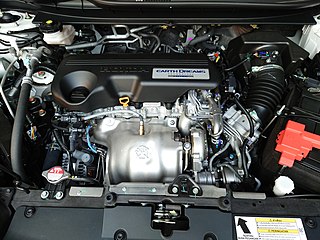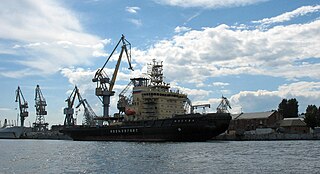Related Research Articles

A V12 engine is a twelve-cylinder piston engine where two banks of six cylinders are arranged in a V configuration around a common crankshaft. V12 engines are more common than V10 engines. However, they are less common than V8 engines.

A V16 engine is a sixteen-cylinder piston engine where two banks of eight cylinders are arranged in a V configuration around a common crankshaft. V16 engines are less common than engines with fewer cylinders, such as V8 and V12 engines. Each bank of a V16 engine can be thought of as a straight-8, a design that can be inherently balanced. Most V16 engines have a 45° bank angle.
A V20 engine is a twenty-cylinder piston engine where two banks of ten cylinders are arranged in a V configuration around a common crankshaft. Large diesel V20 engines have been used in diesel locomotives, haul trucks, electric generators and marine applications.

A V18 engine is an eighteen-cylinder piston engine where two banks of nine cylinders are arranged in a V configuration around a common crankshaft.

MV Captain Kurbatskiy was a Russian SA-15 type cargo ship originally known as Nizhneyansk (Нижнеянск) after a port of the same name. The ship was delivered from Valmet Vuosaari shipyard in 1983 as the second ship of a series of 19 icebreaking multipurpose arctic freighters built by Valmet and Wärtsilä, another Finnish shipbuilder, for the Soviet Union for year-round service in the Northern Sea Route. These ships, designed to be capable of independent operation in arctic ice conditions, were of extremely robust design and had strengthened hulls resembling those of polar icebreakers.

Wärtsilä Oyj Abp, trading internationally as Wärtsilä Corporation, is a Finnish company which manufactures and services power sources and other equipment in the marine and energy markets. The core products of Wärtsilä include technologies for the energy sector, including gas, multi-fuel, liquid fuel and biofuel power plants and energy storage systems; and technologies for the marine sector, including cruise ships, ferries, fishing vessels, merchant ships, navy ships, special vessels, tugs, yachts and offshore vessels. Ship design capabilities include ferries, tugs, and vessels for the fishing, merchant, offshore and special segments. Services offerings include online services, underwater services, turbocharger services, and also services for the marine, energy, and oil and gas markets. At the end of June 2018, the company employed more than 19,000 workers.
Wichmann Diesel was a Norwegian diesel engine manufacturer. Once the largest engine producer in Norway, the company was taken over in 1986 by Wärtsilä. Today the site in Rubbestadneset remains the headquarters of Wärtsilä Norway with a repair yard and a museum.

SEMT Pielstick was a French company that designed and built large diesel engines. Its full name was Société d’Etudes des Machines Thermiques.

The N series is Honda's first automotive diesel engine, an inline-four for medium-sized vehicles. It uses common rail direct injection, which Honda brands as i-CTDi. The most notable feature is the aluminium block, which uses proprietary technology in the manufacturing process to provide light weight and high rigidity. Roller chains drive two overhead camshafts. A variable-geometry turbocharger and intercooler are used.

A V8 engine is an eight-cylinder piston engine in which two banks of four cylinders share a common crankshaft and are arranged in a V configuration.

Vaygach is a shallow-draught nuclear-powered icebreaker. She was built in 1989 for the Soviet Union by Wärtsilä Marine Helsinki Shipyard in Finland by order of the Murmansk Shipping Company. Her sister ship is Taymyr.
Magadan is a Russian icebreaker and the second vessel in a series of three subarctic icebreakers built at Wärtsilä Helsinki shipyard in Finland in 1982–1983. The vessel's sister ships are Mudyug and Dikson.
SCF Sakhalin is a Russian icebreaking platform supply and standby vessel owned by SCF Sakhalin Vessels Limited, a subsidiary of Sovcomflot. The ship was built by Aker Finnyards Helsinki shipyard in Finland in 2005 as FESCO Sakhalin for Far East Shipping Company (FESCO), but was purchased by Sovcomflot and renamed in 2010. Since the beginning it has been in long-term charter for Exxon Neftegas Ltd. and used to supply oil platforms in the Sakhalin-I project.

Wärtsilä is the second largest diesel engine company in the world. Wärtsilä released the Vasa engine series in 1977 and remained in production until 2010. These popular medium speed diesels were produced in Vasa, Finland; hence their name, Vasa. The lead designer of the first engine was Wilmer Wahlstedt. The series comprises three models, the Vasa 22, 32, and 46, with the number denoting the bore size of the engine. Vasa 32 engines are the most popular of the series and can still be found throughout the marine and power generation industries.
Arcticaborg (Арктикаборг) is an icebreaking platform supply vessel. She was previously operated by Wagenborg Kazakhstan in the Caspian Sea but was transferred to Canada in 2017 and acquired by Fathom Offshore in 2018. In 2019, she was contract to Russia for two years.
Georgiy Sedov is an icebreaking platform supply vessel operated by Rosmorport in the Sea of Azov. She was built by Kværner Masa-Yards in Helsinki, Finland, in 1998 as Antarcticaborg for Wagenborg Kazakhstan to be used in the Caspian Sea.

Moskva is a Russian Project 21900 diesel-electric icebreaker. Built at Baltic Shipyard in 2008, she was the first non-nuclear-powered icebreaker built in Russia after the dissolution of the Soviet Union.

The Cleveland Diesel Engine Division of General Motors (GM) was a leading research, design and production facility of diesel engines from the 1930s to the 1960s that was based in Cleveland, Ohio. The Cleveland Diesel Engine Division designed several 2 stroke diesel engines for submarines, tugboats, destroyer escorts, Patapsco-class gasoline tankers and other marine applications. Emergency generator sets were also built around the Cleveland Diesel and were installed in many US warships. The division was created in 1938 from the GM-owned Winton Engine Corporation and was folded into the GM Electro-Motive Division in 1962. The engines continue in use today on older tugs.
Miscaroo was an icebreaking anchor handling tug supply vessel built by Vancouver Shipyards for BeauDril, the drilling subsidiary of Gulf Canada Resources, in 1983. She was part of a fleet of Canadian icebreakers used to support offshore oil exploration in the Beaufort Sea. In the 1990s, the vessel was acquired by Canadian Marine Drilling (Canmar) and renamed Canmar Miscaroo. In 1998, she was purchased by Smit International and served in the Sakhalin oil fields as Smit Sakhalin until 2017 when the 34-year-old icebreaker was sold for scrapping in China.

Dikson is a Russian icebreaker and the final vessel in a series of three subarctic icebreakers built at Wärtsilä Helsinki shipyard in Finland in 1982–1983. The vessel's sister ships are Mudyug and Magadan.
References
- ↑ Medium Speed Engine Project Planning Guides. MAN Diesel & Turbo. Retrieved2011-10-27.
- ↑ Norwegian Spirit. SP Database. Retrieved2011-10-27.
- ↑ Engines & Generating Sets. Wärtsilä. Retrieved2015-06-07.
- ↑ SA-15: a 14 ship series of icebreaking multipurpose cargo ships from Finland for Soviet Arctic Service. The Motor Ship, Volume 64, Issue 753, April 1983. Pages 28-32.
- ↑ "M/S Finnfellow". Archived from the original on 2012-05-25. Retrieved 2013-08-03.. Fakta om Fartyg. Retrieved2011-10-27.
- ↑ New Golden Bridge V. Weidong Ferry. Retrieved2011-10-27.